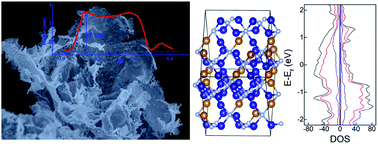Metallic state two-dimensional holey-structured Co3FeN nanosheets as stable and bifunctional electrocatalysts for zinc–air batteries†
Abstract
Exploring economically efficient electrocatalysts with robust bifunctional oxygen conversion catalytic activity and designing appropriate structures are essential to realize ideal zinc–air batteries with high energy density and long lifespan. Two-dimensional metallic state Co3FeN nanosheets with a holey-structured architecture are designed and shown to exhibit enhanced catalytic properties owing to the complete exposure of the atoms in the large lateral surfaces and in the edges of pore areas, together with the lowest OH* adsorption energy on exposed surfaces due to bimetallic synergistic effects. Meanwhile, this porous architecture can not only accelerate electron transportation by its metallic state highly oriented crystallized structure, but also facilitate the diffusion of intermediates and gases. These edge-enriched 2D holey Co3FeN nanosheets exhibit enhanced catalytic activity towards reversible oxygen conversion. When employed in zinc–air batteries, they exhibit a maximum power density of 108 mW cm−2 and cycle life up to 900 cycles with a low round-trip voltage of 0.84 V. The Co3FeN nanosheets maintain a strong stable structure in an oxygen-rich electrochemical environment with a high-orientation crystalline texture during the whole cycling time. This work may provide a promising candidate to promote the further development of zinc–air batteries.



 Please wait while we load your content...
Please wait while we load your content...